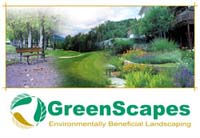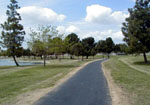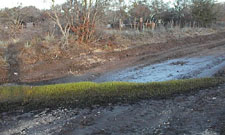What Makes it a GreenScape?
Note: EPA no longer updates this information, but it may be useful as a reference or resource.
This section contains the following:

Product Categories
Biobased Products
These products are composed of biological, agricultural (plant, animal, or marine), or forestry materials that are renewable. Often less harmful to the environment, many products such as compost, fertilizers, cleaners, and solvents, can be found made from biobased materials.
Environmentally Preferable Products
Through the federal-wide Environmentally Preferable Purchasing (EPP) program, Executive agencies are encouraged and assisted in the purchasing of environmentally preferable products and services "that have a lesser or reduced effect on human health and the environment when compared with competing products or services that serve the same purpose." Look on EPA’s EPP Guidance Web page for case studies, guides, labeling, and other related documents for buying your own green products. Also, check out the EPP database of environmental products.
Recycled-Content Products

Many, many products today are made from post-consumer recycled material. The federal government has developed Comprehensive Procurement Guidelines (CPG) for purchasing recycled products, useful to any organization. Check out the CPG website that lists recycled-content recommendations in eight categories of products, including landscaping, park and recreation, and construction products. You can also find manufacturer information, federal product specifications, and additional resources. Read about GreenScapes rebuying suggestions for incorporating recycled-content products into your landscape.
Examples of Large-Scale Landscaping
Brownfields
This term refers to property on which expansion, redevelopment, or reuse may be complicated by the presence of a hazardous substance, pollutant, or contaminant. Brownfields undergoing remediation often benefit from compost use, and such projects are a great opportunity to incorporate recycled products. Investigate EPA’s Brownfields website for information on this topic.

Golf Courses
Due to the large amounts of fertilizer, pesticide, and water needed by most golf courses, these resorts are a great place to begin GreenScaping activities. Biobased products and compost can safely replace pesticides and fertilizers, while xeriscaping techniques reduce water use. For example, the North Shore Country Club in Glenview, Illinois, used compost as a soil amendment to reduce sodium levels at its course. Read about EPA Wetlands Division’s attempt to find common ground between the golf industry and the environmental community through Environmental Principles for Golf Courses.
Green Rooftops
What cooler way to reduce heat, prevent runoff, and help the environment than planting a garden on the roof of your buildings? Creating a green roof provides many opportunities to employ GreenScapes philosophies, ranging from choosing plastic recycled-content containers to soaker hoses made from used tires.
Retail and Commercial Uses
Shopping malls, amusement parks, and other industries associated with large-scale uses of land, have the most room to incorporate GreenScapes’ philosophies. For example, the vast vineyards in Northern California’s wine country are using compost from food wastes to enhance soils.
Military Installations
Military bases can purchase biodiesel and biobased lubricants for equipment, which are better for the environment and allow for the storage of less hazardous materials, reducing management costs and possibly insurance costs. They can also turn their yard and landscaping waste into rich compost and mulch, to eventually be reapplied to the land.

Parks and Recreation Areas
These areas are great places to incorporate benches, tables, and structures made from recycled plastic lumber. Bike paths and walking trails can be made from rubberized asphalt, and ground-up rubber under playground equipment is safer than traditional mulch. Take a look at how some Midwestern and California parks have incorporated plastic lumber and rubberized asphalt into their landscapes.
Railways
New polymers of plastic make this recycled material strong and durable enough for even railroad ties! Biodiesel and biobased lubricants for railroad equipment reduce site management costs due to their less hazardous nature, and can even lower associated storage insurance costs.
Residential and Commercial Building Construction
There are patio blocks on the market containing 90 to 100 percent recovered plastic or postconsumer rubber that can be used to create decorative garden walkways and trails. Buy hoses, tubing, trickle irrigation systems, and lawn edging made from recovered plastic and old tires.

Roadside Landscaping
Many trials have shown that vegetation-less roadside areas, abandoned for years as uninhabitable, quickly flourished under applications of compost. The Texas Department of Transportation applied compost to highway roadsides to prevent erosion and promote regrowth of vegetation. Blankets and berms made of compost minimize or eliminate soil erosion, runoff, and non-point source pollution. Read how Filtrexx International has developed compost products to help control runoff and erosion.
![[logo] US EPA](../gif/logo_epaseal.gif)